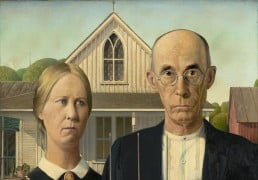Interviews
Studio Visit and Interview: Nick Theobald
On a recent trip to New York, Artland paid a visit to Nick Theobald’s studio to see the current body of work currently on display at Galleri Jacob Bjorn in Aarhus. Here we share an Artland 3D tour of both Nick’s studio and the gallery exhibition, with many of the same works viewable in each of these different and fascinating contexts. We sat down with the artist to ask him all about his work and his unique practice making paintings and sculptures with different kinds of wax.
Your paintings, even though on panel, often have a topography similar to relief. How do you characterise them – do you think of them as paintings even though there is no paint?
I do consider them paintings but more and more I look at all art as records of information, relics of the our century. I see feelings transcribed onto wax, poured over, erased. The layers reveal a passing time. Often I am considering the landscape; the fleeting nature of our natural resources -the scars of the land we inherit from our ancestors overlaid with our own progression.
Your works replay some of the tropes we can recognize in Abstract Expressionism, but also what we understand minimalism to encompass, both of which have cast long shadows over much artistic production in the time since their inception. Given that your works can seem embody this kind of variety, to be a kind of hybridised summary of the modernist canon, do you ever think much about them in this kind of way?
I have actually never really thought of them as hybridized in that way. But I see where you are coming from and appreciate it. And this is something I really enjoy, hearing other interpretations of my work. I find the artist never really understands their own work. We are too close to it, despite playing creator we hold it to an impossible ideal. The information that the viewer receives from the subconscious seems to equally craft my narrative.
And how interested are you in these various antecedents? Perhaps in gestural abstraction, or in Minimalist painting, or even in some works we associate with Arte Povera, with which your work shares some formal and tonal qualities. Do you have artists you have looked up to particularly or been inspired by in some way?
I am aware of history and have an appreciation for those artists that have stood time. But it is not an inspiration or an influence. Categorically it may be where it is easiest to place me. I rarely look at other artists who aren’t my friends. I am no consumer of art. Instead I try to create in as much isolation as possible while living in NYC. Tapping into something perhaps found in darkness, that is my strength.
The materials in your paintings are organic ones – what is the significance of the natural world in relation to your work?
I have always been drawn to ideas of Utopia. How the artist can align with nature is central to my practice. The various sources bees go for during pollination creates a unique autumnal palette. I appreciate a level of indecision in my work which comes from something of the “readymade” that is found in nature. The sponge, the unadulterated wax. Somehow most of the choices are made for me when I’m in the flow.
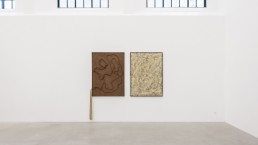
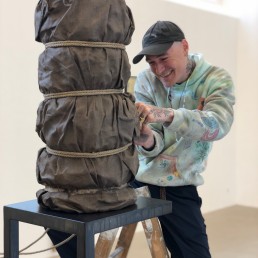
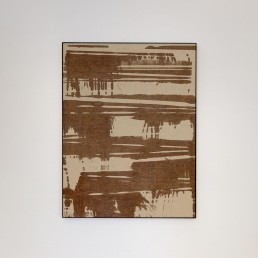
What was it that caused you to discover and experiment with beeswax, which now seems be the pre-eminent leitmotif in your materials?
As a young artist I had difficulty finding my voice, I never felt comfortable using paint. It was about ten years ago that I first started using wax. First I just found what was available easily, but when I began to do research I found a vast variety of tones. And then it clicked. I decided that I had to exhaust this medium of its possibilities…so I keep going. I have romanced the wax to become a vehicle for ideals. There is rich historical symbolism in beeswax which I find poetic.
The manner of making with a substance like liquid wax make the works seem quite process oriented. Do you have very regimented methodologies for making your works, or do you enjoy the happy accidents that come with the pouring and splashing of the materials you use?
The accidents seem to be where the work begins. The initial exploration when I can’t tell if I am crazy or it’s actually good. I quite like that unknowing, though it is difficult to sit with that uneasiness. As I become more acquainted with different ways of using wax the accidents happen less often. So it’s almost about chasing those moments into new territory. And then once discovered, expanding them and stripping them of their secrets. Within this process based vocabulary I have learned to control some part of it, and I use that as the gesture to tell a story.
How have you developed such a wide variety of application of the wax to the surface? Again, these seem to speak of lots of experimentation and technical developments with process, but tell us how you would describe your evolution with the medium.
I think when you are working with any material as an artist it is important to be persistent. Limit oneself to a strict set of parameters. My materials; beeswax, linen, steel, hemp rope, for the most part have remained the same. My works do not radically change from one body to the next. But instead the works continually evolve as individual series. In every work I am striving for a continued sense of balance.
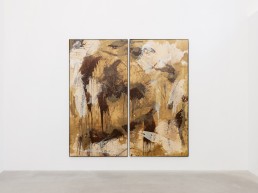
Tell us how this body of work differs for you from prior groups of works you have made. Do you consider an exhibition as a specific body of work, or simply a vehicle for showing a variety of different things you’ve been trying and developing in your practice?
There is always a narrative I am playing out, a drama in my mind based upon my own current personal struggles. The paintings tend to be titled from there. This body of work in particular was made over the last two years. Noting this I am trying to work slowly these days. Just a few tasks a day. I don’t plan on making works for a particular exhibit; instead the works are created more as a comprehensive story and when the time is right they are shown. I find that is authentic to my practice.
Can you explain how your sculpture relates to your paintings? I understand that the sculptures begin with a canvas that has not somehow qualified, in your eyes, to become a finished painting. Can you tell us how you come to this decision and how the two types of work exist alongside each other in your oeuvre?
There is that uneasy feeling to an accident and many of those accidents don’t qualify. The reusing of the materials naturally came just from the sheer cost of waste. But it has also created a spiritual practice of samsara, to transform its energy. There is a process of restraint and setting free.
In my sponge sculptures the idea of the readymade found in nature is explored further. I absorb the skeleton of the sponge in beeswax. Symbolically the beeswax is an everlasting sign of life, paired with the skeleton I was creating a sort of “vanitas”… a reminder of our inevitability.
I had read that you grew up in the Far East. Has the absorption of this culture affected your production in any particular ways you can clearly identify?
Growing up in the Far East developed my sense of material. Especially being in Japan where I learned of “wabi-sabi”. I also pull from a diverse array of metaphysical practices. For me it becomes a bit muddled and I quite enjoy the cross over. I think that is really something that is a marker of our time.
The characteristics of surface and depth possessed by your works, particularly in the yellow monochrome works, provide a kind of iridescent light from within the work, a glow that somehow emanates from them. As such they feel generally positive, yet when one looks over your body of works as a whole that is not the abiding sense. Somehow there is also a darkness across the work that feels inescapable. How would you describe this sense, and is this also something you recognise?
It is something I recognize. My work has become more layered with time. In the earlier works I did not have the same mastery with wax. And therefore what was produced was very straight forward. That place of isolation I mentioned…with time can play with your mind. Sometimes you find joy there and other times you sit to be alone and discover all types of lurking feelings.
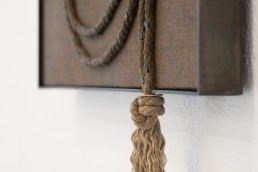
Relevant sources to learn more:
Gallery
Galleri Jacob Bjørn
Opening Times
Thursday 12pm-5pm
Friday 12pm-5pm
Saturday 11am-3pm
or by appointment
An Exclusive Conversation with VOLTA’s New Artistic Director, Lee Cavaliere
Art Fairs,Culture,Articles and Features,Highlights
20. August 2024
Lee Cavaliere is transforming Volta Art Fair with a focus on accessibility and innovation, shaping a more inclusive future for the art world
1 Comment11 Minutes
In Conversation With Julie Leopold, Founder and CEO of Enter Art Fair
Fairs and Events,Articles and Features
7. August 2024
Explore the journey of Enter Art Fair through the eyes of its founder.
0 Comments15 Minutes
Interview: Sophie Neuendorf, Vice President of Artnet
Interviews,Articles and Features
10. July 2024
Sophie Neuendorf shares her unique journey through the art world – a blend of heritage and innovation.
0 Comments9 Minutes
Richard Serra: The Poet of Iron
28. May 2024
One of the most significant artists of his generation, Richard Serra transformed the notion of sculpture through material, movement and scale.
0 Comments9 Minutes
Art Brussels 40th Edition: Curated Highlights
Fairs and Events,Articles and Features
25. April 2024
Dive into Art Brussels 2024 with a curated selection by Edouard Vermeulen & Josée Gensollen.
0 Comments14 Minutes
Celebrating 150 Years of Impressionism
15. April 2024
A series of events commemorates the 150th anniversary of the first Impressionist show, celebrating the movement that ushered in a new era in art.
0 Comments9 Minutes
Art Paris 2024: Between Increased International Gallery Participation & New Curatorial Focus
Fairs and Events,Articles and Features
4. April 2024
Presenting over 136 galleries, 900+ artists, and unique themes, Art Paris 2024 opens at the Grand Palais Éphémère.
0 Comments7 Minutes
Art Movement: American Realism
Articles and Features,Art Movement
27. March 2024
Read about the movement that wished to capture the American landscape and urban spaces in a realistic manner through visual arts and beyond.
0 Comments7 Minutes









